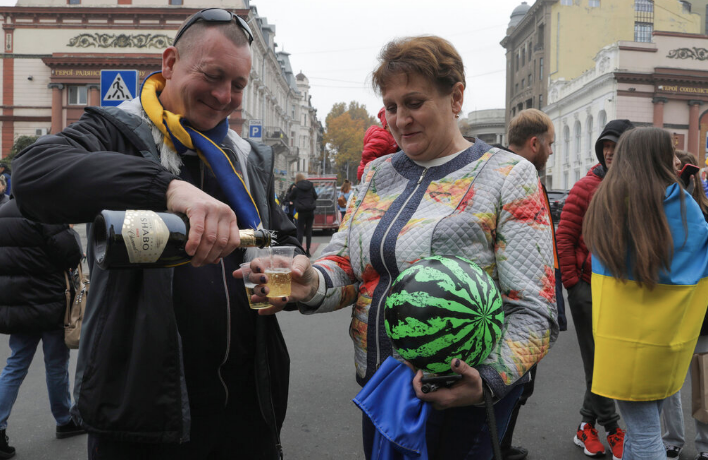Celebrations Continue Amidst Liberation of Kherson
Ukrainians in Odessa celebrate the recapturing of Kherson with champagne, flags, and watermelon-related props, on Nov. 12. Photo: AP Photo/Bernat Armangue
Ukraine’s President Volodymyr Zelenskyy announced on Nov.11 that “Kherson is [Ukrainian]” after Russia effectively withdrew from the southern city– the only provincial capital to be captured by Moscow since the invasion began.
The news that nine months of Kherson’s occupation have ended spread all over the country and sparked immediate celebrations. In Kyiv, Khersonian residents who fled some time ago came together on Maidan Square– draped in Ukrainian flags, holding up signs with triumphant messages, drinking champagne, singing the national anthem, and crying.
On the ground in Kherson, people’s cheerfulness and relief were even more pronounced. Convoys of military men passing through the city were offered bread, flowers, applause, and many hugs and kisses from residents, who they saluted in return– watermelons in hand. Impromptu bonfires were made to fuel the jubilation through the night. The Ukrainian flag is once again flying above Kherson’s administrative building and soldiers are trying to restart internet service after the city’s lengthy blackout during the Russian occupation. There are also plans to repair utilities like the water supply in the coming days.
On the note of watermelons, it’s no surprise that both Ukrainians and allies to their cause embraced this fruit as a symbol of Khersonian liberation. Most watermelons in the country are exported from Kherson, with one of the most important distribution channels being the Dnipro River, along which watermelons travel to Kyiv via ship. This is such a well-known phenomenon in Ukraine that the “watermelon ship” actually runs its own Twitter account, according to BBC Sounds.
Lately, due to Russian control of the city, Khersonian farmers had to pause their watermelon shipments. Thus, the anticipated resumption of watermelon production and sales– at the heart of Kherson’s economy– serves as a representation of the general hope for the resumption of life, peace, and normalcy in the area after last week’s liberation.
To emphasize this connection, everyone from publications like Business Ukraine to Ukraine’s Prime Minister to average citizens are getting creative by sharing or designing their own watermelon-related imagery, such as memes on platforms like Twitter. A watermelon-themed stamp was even released by the Ukrainian Postal Service in commemoration of the liberation, with the words “Kherson – it is Ukraine” on it.
A Khersonian woman hugs a military serviceman on Nov. 12, the day after her city’s official liberation from Russian occupation. Photo: Reuters/Lesko Kromplitz
Despite this positivity, there is a sense of caution in the victory. Kherson’s citizens are well aware that Russians are “not far away.” For many, too, celebration is diminished because their loved ones who have gone out to fight are still missing or detained. Ukraine’s Secretary of the National Security and Defense Council has further warned those who fled Kherson not to return home until the area is fully “stabilized,” since Russian military forces have left mines and other explosives in their wake.
Still, sentiments in the past few days shared by Khersonians all evoke gratefulness and a certain defiance in the face of a larger, national future as of yet unknown. Most can agree that the attainment of freedom from Russian troops was the moment they have been living for all these months and that “[Nov. 11 was] a historic day… the best day of [their] lives.”


